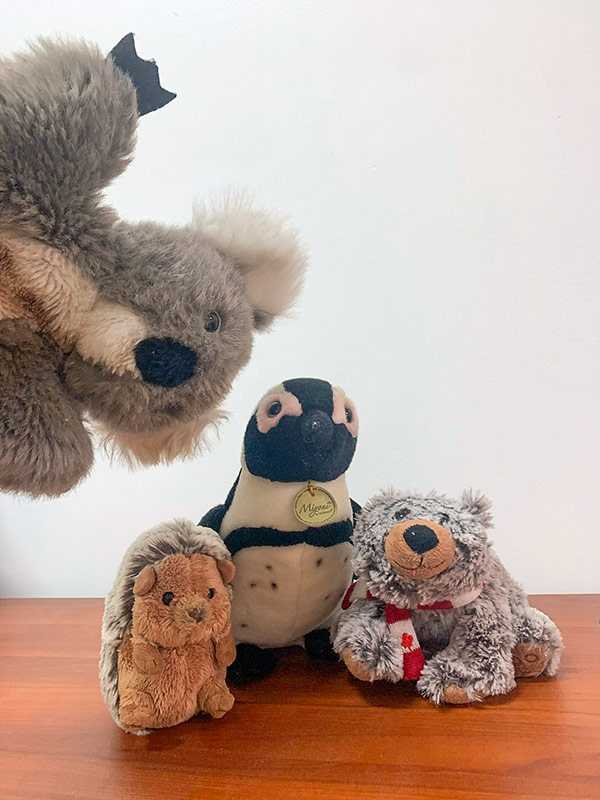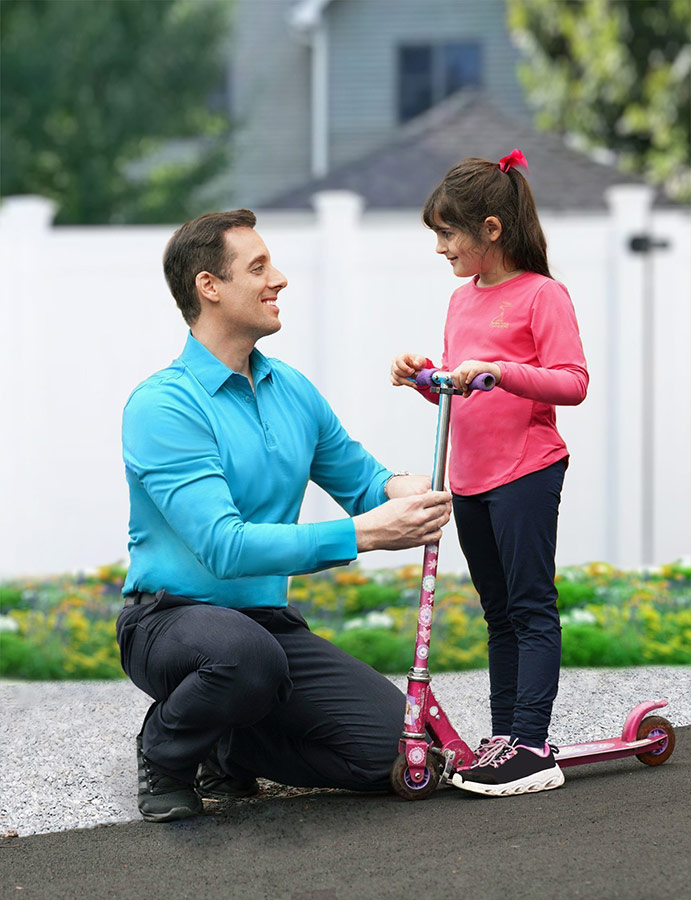Being Daddy on the Road
Fun tips for long-distance relationships with your kids
We’ve been home for so long since the lockdown, it’s easy to forget I’m normally away from my kids half the year.
With Shen Yun, we usually tour from December to May, often not coming home at all during that period. But this past year I not only experienced a full winter and spring at home for the first time (oh, so that’s what this tree does!), but also got to be with our daughters—now 3 and 7—for a full calendar.
Soon, though, as more and more cities and theaters are opening up, we’ll be hitting the road again, and the whole family will need to readjust to the new-old cadence.
The challenge of maintaining a long-distance relationship with your kids is not all that unique. Many parents face it: athletes and their support crew, developers and engineers, scientists, and of course our service men and women, who not only face distance but often daily mortal danger.
But as much as we wish to remind our kids that we love them, help educate them, and bring them joy even when we’re not physically there, it’s not that easy when they’re young.
The ideas below came out of a desperate attempt to hold my daughter’s attention on video call after video call. One set of things worked when she was a baby, another when she was toddler, and yet another when there were two of them.
So if you’re a new dad, or maybe a mom, below are a few fun things I discovered. You veteran parents probably have good tricks of your own, and I’d love for you to share them in the comments section so we can all benefit.
Please keep in mind that:
a. I only have experience through age 6 so far and I’ve got no idea what works with, say, a teenager.
b. Parenting styles and philosophies differ greatly and some may have strong arguments against the need to engage like this on a daily basis.
c. My experience is one of a dad traveling with mom at home. I can’t speak to what it’s like the other way around or if both parents are on the go and kids are with grandparents or other arrangements. I still think much of this applies.
d. Some of these ideas are ridiculous.
So here, in no particular order, are 10 fun tips:
#1: Add a book
So you’re on a video call with your infant boy or girl. You’ve done all the goo goo gaga you can muster and now that it’s been a full 47 seconds, your child no longer cares. You’re losing her!
Quick, take out a book. No, not War and Peace. Something with color. And animals. Lots of animals. Talking animals. One of my daughter’s favorites was The Little Rabbit Who Likes to Say Moo.
Every tour I’d pack a few board books and read them over the video calls, showing the pictures while reading over the top (This also gave mommy a break for five minutes).
If the books start getting old, send them home and buy a couple new ones.
#2: Catch them when they’re eating
Having set times for video calls is a good place to start. I’d often get frustrated when I finally had a five-minute window to say hi only to discover my wife is on a conference call for work and our daughter is napping. Mealtimes are great.
Now, I know mindful eating coaches may disagree, but this is one of those helpful compromises. Baby is in a highchair with no escape route, is being fed and entertained at the same time (As a bonus, and with this the coaches will agree—baby will down a lot of food without noticing).
I should mention that while many of these tips are electronic in nature, we’ve actually chosen to be pretty strict with our kids’ use of devices. During these calls they aren’t allowed to hold the phone—it’s placed in front of them, and when we’re done, we’re done. The devices don’t stay on so they can watch kids movies, like The Silence of the Lambs.
#3: Record yourself singing
I’m not a good singer. But when our daughter was waking up five times a night and my wife was exhausted, I handled bedtime during the months I was home. After bath, pajamas, milk, and books it was finally lights out and go to sleep already! One thing that worked was singing. My daughter was faced with a choice: Either fall asleep, or suffer through daddy’s “singing.”
“But what'll happen when you go on tour?” my wife asked. She had me record the singing, which was about 20 minutes long, and played it for our daughter as she fell asleep. For better or worse, daddy’s singing was the last thing she heard as she closed her little eyes every night. Somehow she still seems normal.
#4: Get a puppet
That’s not a typo, although a puppy would certainly hold their attention. But a hand puppet works great. I got a koala one in Australia when my daughter was 2. And although I work for a performing arts company, I’ve never been mistaken for a puppeteer. When it comes to puppets, I’m as creative as a cabbage.
And yet, this worked. Koala would make his on-screen appearance, agree or disagree with things daddy said off camera, and often get into little tiffs over being in the spotlight. Koalas are, after all, known to be hams.
#5: Stuffed animal adventures
After Koala came Pingee the Penguin, who I bought at a Whole Foods in Chicago. Then came Pokey and Sad Cat, from a mall somewhere, and Canada Bear from literally any rest stop north of the border. These stuffed animals were imbued with personality and, like the puppets, made regular appearances on video calls.
What you do is try having a normal conversation with your 3-year-old and then, when you start losing her attention, bring out the new friend. True, after a while she will ask to see the stuffed animal instead of you. That’s life. It’s good preparation for when she finds another important man—some forty years down the road.
But here is the real tip, to reward you for not just reading the headings. Make videos of these stuffed animals having adventures.
The biggest hit with my daughters was Pingee’s shenanigans. Whenever we arrived at a new hotel, Pingee would go exploring. He’d jump on and off the bed. He’d activate the faucet’s automatic sensor and then dart out of the way. He’d hop on the treadmill and get flung across the room. My daughters could watch these ridiculous, low quality, shaky cam videos to no end.
As we got closer to the end of tour, I’d tell them about how Pingee or Sad Cat were eager to meet them in person, and how we would do so soon. When I came in through the door, as soon as I put down my bags they asked to see them.
#6: Take short videos of yourself
Some days our schedules just wouldn’t line up, especially if we were in Asia or Australia. Instead of going days without saying hi, my wife encouraged me to send short videos.
These videos can be under a minute (which makes them easier to send) and can be as simple as:
“Hey, how are you? Here I am in my dressing room—what do you think of these lights? They’re really yellow, huh? Here’s my friend, say hi… Anyway, hope you’re having a good day—I gotta get ready for the show now. Talk to you tomorrow. Bye!”
Over time, whenever we went sightseeing or came across something interesting, I’d take out the phone and do a short video. I’d start with it pointing at me saying hi, then turn it around to show a cool fountain, strange animal, or anything else I thought they’d enjoy.
The beauty of these videos is that you can take them whenever you have time and they can watch them whenever they have time. Over and over and over again.
And they can also send you videos back!
#7: Postcards
We take a break from the electronic to visit one of the most traditional travel communication methods: the postcard. These are cheap, ubiquitous—gas stations, airports, hotels, and make for a nice surprise. Especially as your kids learn to read, you can send them postcards with simple messages in all caps. Don’t forget to put one in the mail for mom, too.
#8: The gift box
This is a bigger project, and one I’ve only attempted a couple times. But imagine the joy of a little kid getting a package in the mail with something just for them… Right, Amazon. But still, a box full of stuff from daddy, whom we haven’t seen in months? You can include toys, books (the ones you’re tired of reading), exotic snacks, and other gifts. It’s also helpful if you’re constantly picking up little chachkas and your suitcase zippers are feeling the burden.
#9: Gummy bears
What? First videos, now sugar? What kind of parent are you? No, no, no, this is really just teaching the kids math. You know the old American saying: “A gummy bear a day when daddy is away.”
Before leaving for tour, I gave my daughter a carefully counted Ziploc bag of gummy bears. There was one gummy bear for each day I was away. Every night after dinner she had one gummy bear. Not only was this sweet, it also gave her a good sense of progress. “Daddy, I finished all the blue ones! Now I only have red, orange, and yellow left!”
#10: Record stories
This last fun tip is one where I can do a bit more heavy lifting in terms of education.
The easiest here is to record some kids books. Before leaving for tour one year, I chose five of their favorites and recorded them. The girls could listen while mommy was making dinner or on a long car ride. They could turn the pages and follow as well. It’s like a personalized version of those old Read Along vinyl records.
But you can personalize it even further by making up the stories.
One day, on another long bus ride, I was thinking about a few important ideas I wanted my 4-year-old to understand. For example, treating everyone with kindness, or doing things well. At the time, she loved the story of Goldilocks and so we had already invented a couple Goldilocks tales—Goldilocks and the Three Mermaids, Goldilocks and the Flying Dragon… they could have been classics.
So I recorded me telling her different stories about Goldilocks embodying the things we wanted to address. In one example, it was time for my daughter to let go of her nighttime pacifier. The story was called: “Goldilocks and the Magic Pacifier Tree.” Basically a purple rock suddenly appears in the yard next to a tree, telling Goldilocks this is the magical pacifier tree, and then she goes and hangs all the pacifiers on it as decorations because she doesn’t need them any more.
After I came home from tour, a purple rock somehow, magically, manifested by a tree in our yard. We went out and hung up the pacifiers, where they hang still, and she never asked for them again.
* * *
Okay, ten is a good place to stop, plus I think that about covers it. Oh, I guess there a few other quick tips:
Sometimes, if schedule and finances allow, you can arrange a family rendezvous on tour to break up the long time away.
If you have two or more kids, giving each of them individual attention on the calls—talking to them one at a time as well as together—is really important.
You can also ask the older child to be mommy’s little helper, giving them a sense of responsibility and purpose, and maybe occasionally actually being helpful.
Bonus tip about coming back

Ease back in to the family rhythms. Be ready for an adjustment period and be patient. My wife jokes that every year when I come home we slowly get our act back together and just when it’s perfected, it’s time to go on tour again. Such is the cadence.
While you’ve been traveling, the family has found a way to operate without you and developed habits you may not agree with or understand—some of which are solving problems you didn’t even know existed because you weren’t there when they came up. I recommend watching, observing, and talking through them.
In spite of all the efforts, the kids, especially little ones, may still take some time to warm back up. But they usually do super fast, so be gentle and hang in there.
* * *
That’s it. I hope some of these tips are useful or, better yet, spark a new idea in you. Especially if you’re a new parent, or you suddenly need to travel, or you’re away from home going through a tough time—I hope these fun tips help.
When we’re away from home for months on end, being regularly engaged makes our kids feel better, and makes us feel better too.




















